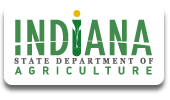According to this years annual conservation survey, Indiana farmers planted an estimated 1.7 million acres of overwinter living covers, an increase of about 100 thousand acres from 2023.
Overwintering living covers (i.e. - cover crops and small grains, like wheat) are known for their environmental benefits. Cover crops and small grains help increase organic matter in the soil and improve overall soil health by adding living roots to the soil additional months out of the year. Cover crops also improve water infiltration into the soil, while other covers, like legumes serve as natural fertilizers. The 1.7 million acres of living covers planted sequestered an amount of soil organic carbon that is the equivalent of 889,000 tons of CO2.
Although the conservation transect does not differentiate between cover crops and small grains, Indiana farmers typically plant fewer than 300,000 acres of small grains annually, so cover crops vastly dominate the 1.7 million estimated acres. Apart from corn and soybeans, cover crops are planted on more acres than any other commodity crop in Indiana. Cover crops are typically planted in the fall after harvest and designed to protect the soil and keep roots in the ground throughout the winter, which improves soil health and helps filter water runoff.
As a result of the cover crops and other overwintering covers planted last year, it is estimated that 1.8 million tons of sediment was prevented from entering Indiana’s waterways, which would fill about 18.4 thousand train freight cars.
The conservation survey also showed that about 69% of row crop acres were not tilled and 17% had employed reduced tillage over winter, after the 2023 harvest. This early spring survey is not intended to quantify pre-planting tillage.
The conservation transect is a visual survey of cropland in the state. It was conducted in the late winter to early spring of 2024 by members of the Indiana Conservation Partnership, including the USDA Natural Resources Conservation Service, the Indiana State Department of Agriculture, Indiana’s Soil and Water Conservation Districts and Purdue Extension, as well as Earth Team volunteers, to show a more complete story of the state’s conservation efforts.
